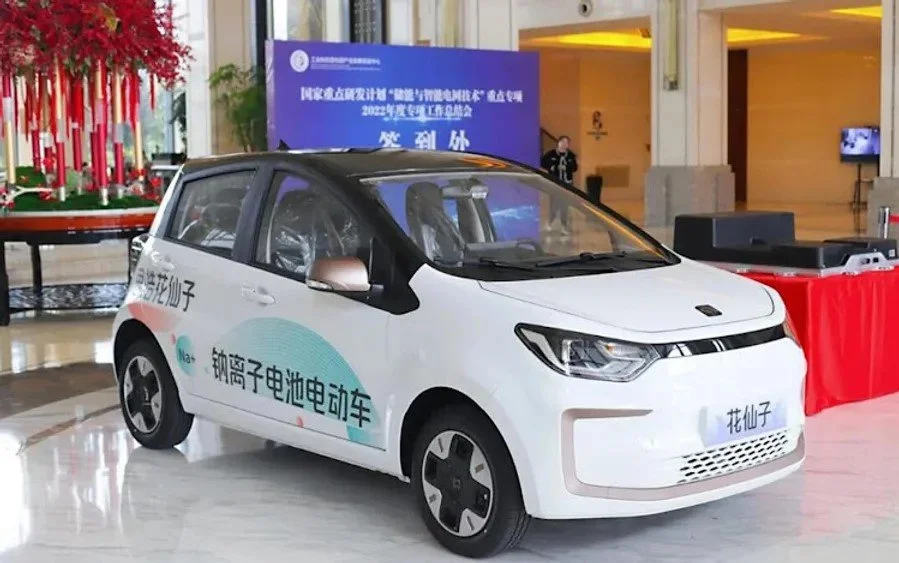What’s the future of EV battery technology?
Three very exciting battery technologies are coming. In this first piece in a three part series we dive into a promising low cost and environmentally friendly alternative - sodium ion.
The world’s first Sodium Ion battery powered car - the The Hua Xianzi is fitted with a 25kwH Na-ion battery that can travel up to 250 kilometres on a single charge
Batteries are the limiting factor for EVs, as they set how fast they can charge, how far they can go per charge, how cheap they can be built, and even their safety levels and ecological impact.
As soon as batteries become more affordable, have reduced environmental impact, can charge very quickly, and provide a practical range of more than 400 miles then EVs will truly have come of age and even the most fervent anti-EV campaigners will struggle to find anything to criticise about them.
Current technology recap
Before we explore future battery chemistries let’s first recap on how current batteries work - lithium ion.
Lithium-ion car batteries operate on the same fundamental principles as the batteries in our smartphones and laptops, but with a few critical enhancements to meet the demands of automotive use. At their core, these batteries store and release energy through the movement of lithium ions between two electrodes: the cathode and the anode. The magic lies in the chemistry and design that makes this process efficient, safe, and capable of delivering the high power required for vehicular applications.
The cathode, typically made of lithium iron phosphate plays a crucial role in determining the battery's energy capacity and power output. On the other side, the anode is usually composed of graphite, which can efficiently host the lithium ions during charging and discharging.
During charging, an external power source drives electrons into the battery, causing lithium ions to move from the cathode to the anode. This process is known as intercalation. Conversely, during discharging, the stored lithium ions move back to the cathode through an electrolyte solution, releasing energy that powers the vehicle. The electrolyte acts as a bridge, allowing ions to move between the two electrodes while preventing direct contact, which could lead to short circuits.
Safety features are paramount in lithium-ion batteries, especially in the demanding automotive environment. Battery management systems monitor the state of charge, temperature, and voltage to ensure optimal performance and prevent overheating or overcharging.
The main limitations of lithium-ion batteries include:
Limited energy density. While advancements have improved energy density over the years, it's still a limiting factor for EVs seeking to achieve longer ranges without significantly increasing the size or weight of the battery pack.
Resource Availability: Lithium-ion batteries rely on raw materials like lithium, cobalt, and nickel. The availability of these materials can be a concern, especially as EV adoption grows. Mining and refining these resources can have environmental and ethical implications, particularly in regions where labor conditions and environmental standards may not be stringent.
Safety Concerns: While lithium-ion batteries have generally demonstrated a good safety record, there have been instances of battery fires and thermal runaway, which can result from factors like manufacturing defects, overcharging, or physical damage to the battery pack. Ensuring the safety of EVs requires sophisticated battery management systems and safety protocols.
New technology 1 - Sodium Ion Batteries
The sodium-ion pack powering the Hua Xianzi car above (image: HiNa Batery)
Similar to their lithium-ion counterparts, sodium-ion batteries operate based on the movement of ions between electrodes. The key difference lies in the type of ions involved. Sodium-ion batteries use sodium ions instead of lithium ions, which can be more abundant and less expensive, contributing to a more sustainable energy landscape.
In these batteries, the cathode and anode play central roles in the energy storage process. The cathode, often composed of materials like sodium iron phosphate or sodium manganese oxide, accepts and releases sodium ions during charging and discharging cycles. Meanwhile, the anode, usually constructed using carbon-based materials, holds the sodium ions during these processes.
The chemistry might be similar, but sodium-ion batteries face distinct challenges. They tend to have a slightly lower energy density compared to lithium-ion batteries, affecting the range and performance of electric vehicles. Additionally, sodium ions are larger than lithium ions, leading to certain design adjustments to accommodate their size during insertion and extraction.
Despite these challenges, sodium-ion batteries offer intriguing advantages. They are more abundant and widely distributed than lithium, potentially reducing concerns about resource scarcity. Their affordability could also make electric vehicles more accessible to a broader range of consumers.
This light-footed impact on the planet translates into cost savings. A lithium-ion battery costs around $132 per kWh, but sodium-ion can cost as little as $40 per kWh, or 70% less! What’s more, a sodium-ion can charge from 10% to 80% in only 15 minutes, about twice as fast as many lithium-ion cells, and lasts almost twice as long with a lifespan of 3,000 cycles. They are also safer, as they don’t pose as much of a fire risk as lithium-ion. But they are less energy dense. A lithium-ion pack hovers around 220 Wh/kg and peaks at close to 300 Wh/kg. Meanwhile, a sodium-ion battery is up to 160 Wh/kg, with some extraordinary lab cells reaching 200 Wh/kg. That means a sodium-ion pack will weigh 40% more!
You might think this energy density makes sodium-ion batteries near useless. But, as the battery constitutes a third of the cost of an EV, the price difference of the sodium-ion battery more than makes up for its lack of energy density. What’s more, its superfast charging ability and long life cycle makes cheaper, shorter range EVs actually practical to own.


